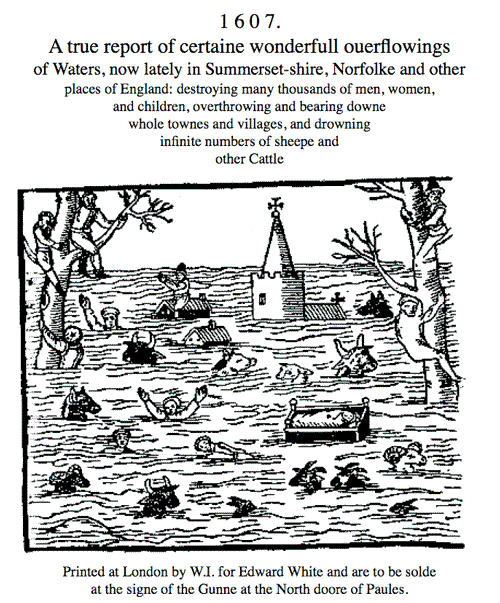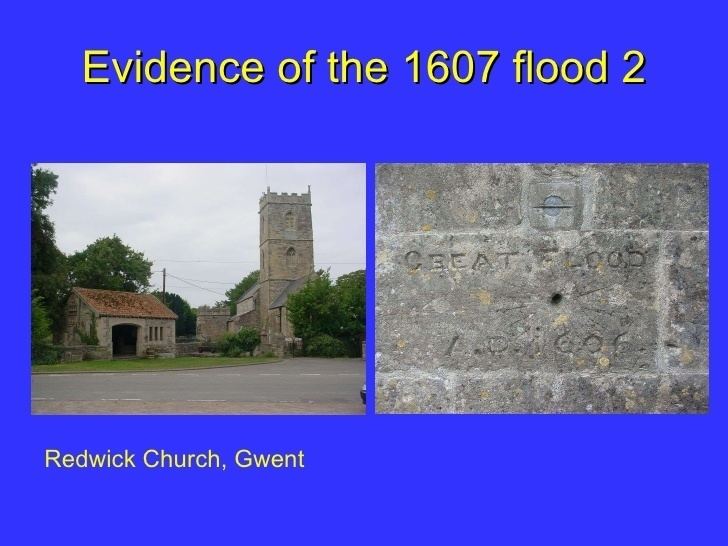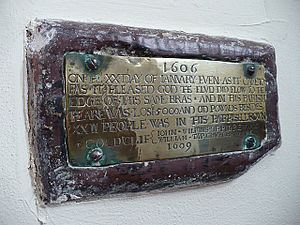 | ||
Similar London tornado of 1091, Holmfirth floods, Autumn 2000 western E, 2008 Morpeth floods, North Sea flood of 2007 | ||
The Bristol Channel floods, 30 January 1607, resulted in the drowning of a large number of people and the destruction of a large amount of farmland and livestock. Recent research has suggested that the cause may have been a tsunami.
Contents
- Description
- Possible causes
- Tsunami hypothesis
- Tsunami evidence
- Storm surge hypothesis
- Future recurrence
- References

Description
On 30 January 1607, around noon, the coasts of Bristol Channel suffered from unexpectedly high floodings that broke the coastal defences in several places. Low-lying places in Devon, Somerset, Gloucestershire, and South Wales were flooded. The devastation was particularly severe on the Welsh side, extending from Laugharne in Carmarthenshire to above Chepstow in Monmouthshire. Cardiff was the most badly affected town, with the foundations of St Mary's Church destroyed.

Floods resulted in the drowning of an estimated 2,000 or more people, with houses and villages swept away, an estimated 200 square miles (51,800 ha) of farmland inundated and livestock destroyed, wrecking the local economy along the coasts of the Bristol Channel and Severn Estuary.

The coast of Devon and the Somerset Levels as far inland as Glastonbury Tor, 14 miles (23 km) from the coast, were also affected. The sea wall at Burnham-on-Sea gave way, and the water flowed over the low lying levels and moors. Thirty villages in Somerset were affected, including Brean which was "swallowed up" and where seven out of the nine houses were destroyed with 26 of the inhabitants dying. For ten days the Church of All Saints at Kingston Seymour, near Weston-super-Mare, was filled with water to a depth of 5 feet (1.5 m). A chiselled mark remains showing that the maximum height of the water was 7.74 metres above sea level.

A number of commemorative plaques still remain, up to 8 feet (2 m) above sea level, showing how high the waters rose on the sides of surviving churches. For example at Goldcliff near Newport the church has a small brass plaque, inside on the north wall near the altar, today about three feet above ground level, marking the height of the flood waters. The plaque records the year as 1606 because, under the Julian calendar in use at that time, the new year did not start until Lady Day, 25 March. The estimate of resultant financial loss in the parish is given as approximately £5,000 (equivalent to £970,000 in 2015).

The flood was commemorated in the contemporary pamphlet entitled God's warning to the people of England by the great overflowing of the waters or floods.
Possible causes

The cause of the flood remains disputed, insofar as contemporary explanations blamed God. Subsequent scientific explanations ignored much of the written evidence and blamed bad weather, until recent research suggested a tsunami. Traditionally it had been believed that the floods were caused by a storm surge, a combination of meteorological extremes and a high tide.
Tsunami hypothesis
Written evidence from the time describes events that were similar to those that unfolded in the 2004 Indian Ocean earthquake and tsunami, including the sea receding before the wave arrived, a wave of water that rushed in faster than men could run, sparks coming off the top of the wave, and a crowd of people who stood and watched the wave coming towards them until it was too late to run. Some of the most detailed accounts also state that it had been a sunny morning.
A 2002 research paper, following investigations by Professor Simon Haslett of Bath Spa University and Australian geologist Ted Bryant of the University of Wollongong, suggested that the flooding may have been caused by a tsunami, after the authors had read some eyewitness accounts in the historical reports which described the flood.
A BBC programme exploring the theory, The Killer Wave of 1607, was made as part of the Timewatch series. Although made prior to the 2004 tsunami disaster, it was not broadcast until 2 April 2005 and was repeated on 24 January 2007.
The British Geological Survey has suggested that as there is no evidence of a landslide off the continental shelf, a tsunami would most likely have been caused by an earthquake on a known unstable fault off the coast of Ireland, causing the vertical displacement of the sea floor.One contemporary report has been identified which describes an earth tremor on the morning of the flood.
Tsunami evidence
Haslett and Bryant found significant evidence for the tsunami hypothesis. This included: massive boulders that had been displaced up the beach by enormous force; a layer up to 8 inches (20 cm) thick composed of sand, shells and stones within an otherwise constant deposit of mud that was found in boreholes from Devon to Gloucestershire and the Gower Peninsula; and rock erosion characteristic of high water velocities throughout the Severn Estuary.
Storm surge hypothesis
There are similarities to descriptions of the 1953 floods in East Anglia which were caused by a storm surge. Some of the original sources frequently referred to the high spring tide and strong winds from the southwest, classic conditions for a storm surge. Horsburgh and Horritt have shown that the tide and probable weather at the time were capable of generating a surge that is consistent with the observed inundation.
Future recurrence
While the risk of similar future events is considered to be low, it is estimated that the potential cost caused by comparable flooding to residential, commercial, industrial, and agricultural property could range from £7 to £13 billion at 2007 insured values. Concern has also been expressed that the nuclear power stations at Hinkley Point and Oldbury could be endangered.RMS 2007, p. 17
On the 400th anniversary, 30 January 2007, BBC Somerset looked at the possible causes and asked whether it could happen again in the county.
